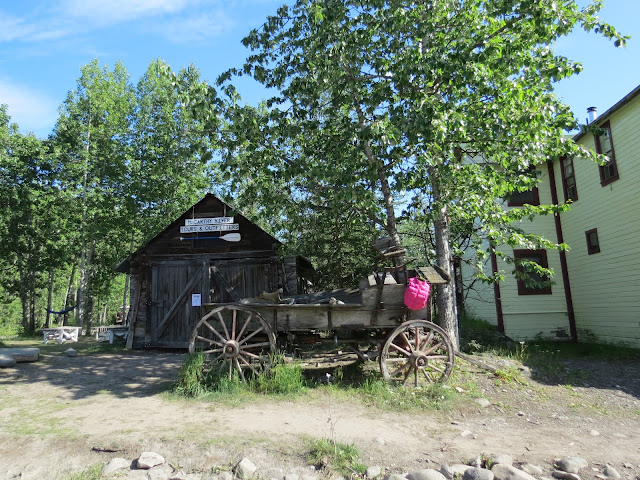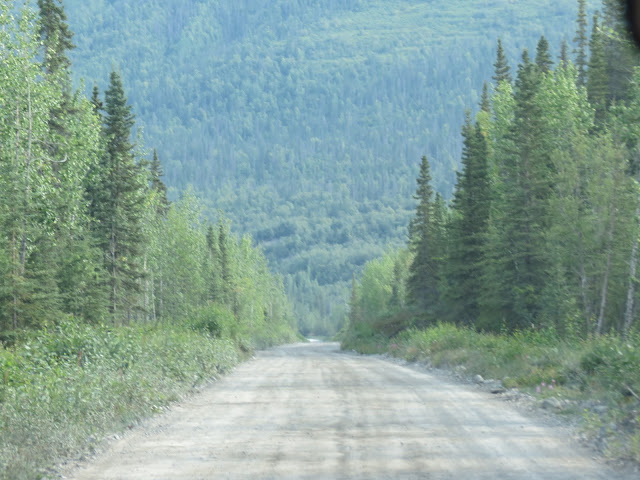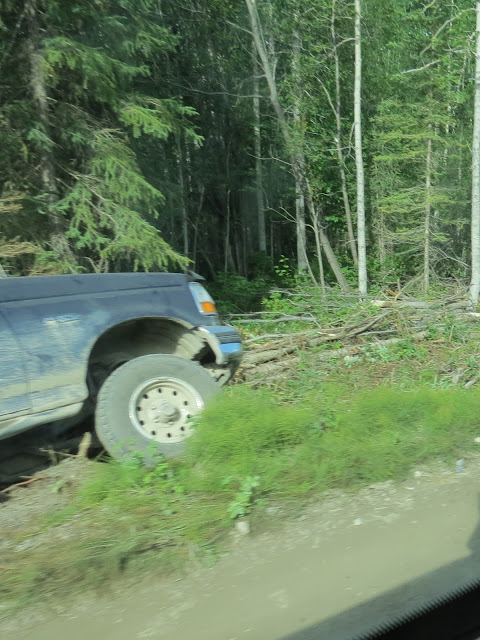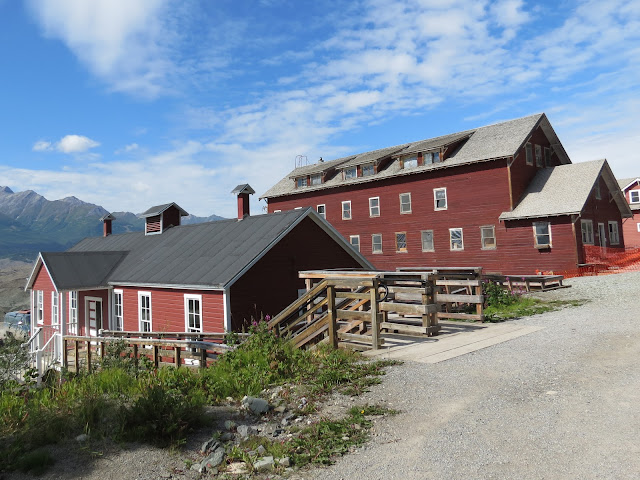As we drove out the Edgerton Highway to Kenny Lake, we watched the Wrangells "move." From Copper Center Mt. Drum is on the right of Mt. Sanford. As we travel south, Mt. Drum moves to the left as you see it in this photo.
The Kennecott Shuttle picked us up at our campground at 8 a.m. We traveled the remainder of the paved Edgerton Highway to Chitina (pronounced
Chit-nah). The town of Chitina is an example of a Boom & Bust community that came and went with the Gold Rush.
Originally, Chitina was a relatively wealthy Native village with access to both salmon and copper, located at the southern entrance to the Copper Valley. After 1901, Gold Rush miners staked claim to the copper deposits, and by 1903 the Guggenheims had bought them out. By 1911, Chitina became the terminus and shipping hub of the copper company's railway.
Past Chitina, the road turns to gravel and passes through a narrow old railroad cut to a 1400 foot bridge across the Copper River.
This reminds me of our trip to the Arctic Circle trying to get photos from the back of a van as it bumps along.
Beautiful view of the confluence of the Copper and Chitina Rivers though.
Our driver told us we would stop to watch the fish wheels on the way back.
It doesn't take long to come upon construction on the road.
We met a lot of large trucks and other types of road equipment spewing dust clouds.
We stopped here to view an abandoned railroad trestle across Gilahina creek. A total of 271 wooden trestles were constructed, spanning over 30 miles of rugged landscape.
The Gilahina would be the largest at over 90 feet tall and 880 feet long. It was quite a challenge in January 1911, with frozen ground and temperatures as low as -67 degrees. In spite of conditions, this trestle was completed in just 8 days.
After that break, we continued down the dusty road...
Where we waited for more construction work.
Finally, about 11 a.m., we arrived at the footbridge to McCarthy and Kennecott. The sun is shining, and we are smiling.
From the footbridge we can see the Kennicott Glacier. A couple of truck campers have traversed the road. There is a fee for parking and camping here. I know I made the right decision for me by not bringing my RV over that rough road, and using the shuttle instead.
We walk about 1/2 mile to the town of McCarthy. We'll get on another shuttle there to go the remaining 4 1/2 miles to Kennecott.
We pass the only church, McCarthy-Kennecott Community Church.
There is another footbridge to cross. From here you can see the Kennicott Glacier on the left, and the Kennecott Mill town on the right in the distance. You may have noticed the different spellings...the glacier was named "Kennicott" after an actual person. But the Guggenheims misspelled their new mines, "Kennecott." Either spelling is accepted now.
This creek is the source of drinking water for the town of McCarthy, so please tell Stuart and the other dogs not to swim in it.

Hmmm, there may be some strange wildlife way out here. Be on the lookout. The red building houses a museum, which unfortunately we did not have time to visit.
We did do a quick walking tour of McCarthy. McCarthy is a genuine "end of the road" town with a small year-round population that has moved into or built houses around what was once a thriving supply center.
There are only a handful of these towns left...Eagle, Chitina, Talkeetna, and McCarthy. All have retained some of their original buildings.
We looked but did not wander down a couple of side streets.
This old store is now a private residence.
Restaurants, gift, shops and tour companies operate out of the remaining buildings on the main street.
Rusting remnants of a mining town.
Our shuttle arrived and took us to Kennecott.
Wonder if the dust was so thick this driver couldn't see the road?
Kennecott Mines and town are being restored and preserved as a national historic landmark.
We are dropped off at the edge of town.
The first big building we pass is the Kennicott Glacier Lodge, a more contemporary structure built to accommodate tourists, but built to blend in with the style of the other buildings.
We headed for the Visitor Center first to get information and pick up a map for our walking tour. The building in the foreground is the West Bunkhouse. It is being stabilized and restored (removing lead paint and asbestos) and so is not open to the public.
You know what this is.
Our first view of the red mill buildings, stair-stepping into the mountain, is quite impressive.
The Visitor Center is impressive too. It housed the U.s. Post Office and General Store, and has been restored with authentic inventory from the mill-town era.
Only the labels are authentic....doubt if there's any soup in those cans.
Families could purchase just about anything that could be found in the "lower 48."
If the store did not have it, an order could be placed through popular catalogs.
Why the town was here.
Reading those soup labels made us hungry, so back to the lodge we went for lunch. We ate outside.
I had the chef's special....hot pastrami on rye. Very good.
And Birdie enjoyed her French Dip as well.
On with our tour. This is the larger of two schools that were built. Imagine attending class next to a towering glacier and an extremely loud copper mill. Classes were also provided for adults in the evening...English and citizenship courses. By 1920 there were 126 students from 23 nations, but the largest class size was 20 children.
This was a refrigeration plant. The town had its own dairy to provide fresh milk, cheese, and meat.
Meat hooks are still hanging inside.
Ammonia was used in the cooling process.
We returned to the Visitors Center to watch a film about the town. This clip depicts Kennecott in the middle of winter.
The glacier you see in the distance filled the valley in the early 1900s.
There have been 2 major floods that have damaged or destroyed buildings along National Creek. The latest was 2006.
The red buildings on the right were bunkhouses for single men workers who came and went. The length of stay varied from 3 months to several years. It took workers 3 months to pay off their train fare. The white/gray building housed a hospital which was home to Alaska's first X-ray machine. Employees were charged 8 cents a day for medical care.
This was the General Manager's Office and is open for touring.
On the wall were photos...this one from 1927.
An old safe in a fire-proof vault.
This trail leads (uphill) to the top of the mill building, puff, puff.
Waterfall. National Creek provided water for the town.
THere were 5 mines at Kennecott, high in the mountains behind the mill. Ore was transported by tramway at a rate of 1200 tons per day. From the tram, ore went through a series of crushers and sorters, using gravity and water to move the rock from one process to the next.
That should keep the curious out.
Once the tailings were removed, the ore was loaded into burlap bags and stacked on open rail cars to be shipped to the coast.
Some of what you see are tailings or waste rock from the mine, but much of it is glacial moraine. I'm not sure which is which.
There is a trail out to the glacier which we did not have time for, but if I ever come again, I would do. You can see some hikers out there.
There are also trails to two of the mines....next time.
These piles of rocks I believe are waste tailings from the mill's concentration process.
Middle and upper management employees were housed in single-family cottages. They paid about 1/4 of their income for the privilege of having their families with them.
Some of them show the effects of time and harsh conditions.
But this one has been restored and is open. The location of the cottages reflected rank as an employee. This one is right next to the tracks. Others are on the hill behind the mill on what is known as "Silk Stocking Row."
There was a living room, kitchen-dining, 2 bedrooms, and a bathroom with indoor plumbing.
Reading these accounts of cottage life was interesting.
The modern kitchen then,
and now.
Birdie is talking to this worker about the window glazing process. She said her training was doing the one to her right. She is now working on her first window by herself. Birdie gave her some tips about helpful tools she could be using. Apparently Birdie has some experience in window glazing.
A peek inside the power house. The plant used 2 diesel generators, one steam turbine, and a Pelton waterwheel to provide power and steam heat to the entire town.
More stabilization work underway. Got a "butt" shot of one of the workers in a window.
There's a lot of debris still lying around, but in the distance something else:
A black bear munching on soapberries.
So what else is there to do at Kennecott besides tour the town? How about swimming?
Or rafting? Flightseeing is available too, and don't forget those hikes.
At 4 o'clock we boarded our van for the return trip. We passed some pretty lakes.
Oh yeah, I almost forgot...
Some scenic mountains,
Some dust...worse when you have to follow a truck for awhile.
Maybe a good time for a nap if you don't have to drive.
Or just reflect on all you saw and learned.
We stopped at the one-lane Kuskulana Bridge...525 feet long, 238 feet above the river. Built in 1910 in terrible weather.
A look down from the bridge.
And as promised, we stopped to see the fish wheels on the Copper River.
These homemade paddlewheel fish traps are used by Native A;askans who are permitted to catch salmon in this manner.
Captured this shot of a Golden Eagle flying over the fish traps.
Would I go again? Absolutely! Would I drive my RV out there? Absolutely not! The 60-mile dirt road was built over a railroad bed. Rail spikes sometimes surface through the washboard, and rain makes the road slippery. No point in endangering my home when there are other ways to get there. If I come again, I think I might take the shuttle and stay overnight in the Lodge so there would be time to do the hikes. Just my opinion.






























































































A great trip. Let's see, you and Birdie had jackets on and others were swimming. They must have been natives. Thanks for explaining the fish wheels. It sounds like a great trip and definitely wise not taking either RV or even Herbie.
ReplyDeleteWhat a great trip! I would want to walk out on the glacier and hike to the mines, if there was time. Very neat little town.
ReplyDelete